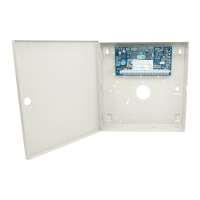Safety Instructions for Service Personnel
Warning: When using equipment connected to the telephone network, always follow the basic safety instructions provided
with this product. Save these instructions for future reference. Inform the end-user of the safety precautions that must be
observed when operating this equipment.
Before Installing The Equipment
Ensure your package includes the following items:
l Installation and User manuals, including the SAFETY INSTRUCTIONS.
READ and SAVE these instructions!
Follow all WARNINGS AND INSTRUCTIONS specified within this document and/or on the equipment.
l HS2016-4/HS2016/2032/2064/2128 alarm controller
l Power Supply, direct plug-in
l Mounting hardware
Selecting A Suitable Location For The Alarm Controller
Use the following list as a guide to find a suitable location to install this equipment:
l Locate near a telephone socket and power outlet.
l Select a location free from vibration and shock.
l Place alarm controller on a flat, stable surface and follow the installation instructions.
Do NOT locate this product where people may walk on the secondary circuit cable(s).
Do NOT connect alarm controller to electrical the same circuit as large appliances.
Do NOT select a location that exposes your alarm controller to direct sunlight, excessive heat, moisture, vapors, chemicals or dust.
Do NOT install this equipment near water. (e.g., bath tub, kitchen/laundry sink, wet basement, near a swimming pool).
Do NOT install this equipment and accessories in areas where risk of explosion exists.
Do NOT connect this equipment to electrical outlets controlled by wall switches or automatic timers.
AVOID interference sources.
AVOID installing equipment near heaters, air conditioners, ventilators, and refrigerators.
AVOID locating equipment close to or on top of large metal objects (e.g., wall studs).
See "Locating Detectors and Escape Plan" on page 221 for information on locating smoke and CO detectors.
SAFETY Precautions Required During Installation
l NEVER install this equipment and/or telephone wiring during a lightning storm.
l NEVER touch uninsulated telephone wires or terminals unless the telephone line has been disconnected at the net-
work interface.
l Position cables so that accidents can not occur. Connected cables must NOT be subject to excessive mechanical
strain.
l Use only the power supply provided with this equipment. Use of unauthorized power supplies may cause damage.
l For direct plug-in versions, use the transformer supplied with the device.
WARNING: THIS EQUIPMENT HAS NO MAINS ON/OFF SWITCH. THE PLUG OF THE DIRECT PLUG-IN POWER SUPPLY IS INTENDED
TO SERVE AS THE DISCONNECTING DEVICE IF THE EQUIPMENT MUST BE QUICKLY DISCONNECTED. IT IS IMPERATIVE THAT
ACCESS TO THE MAINS PLUG AND ASSOCIATED MAINS SOCKET/OUTLET IS NEVER OBSTRUCTED.
IMPORTANT NOTE FOR NORTHAMERICA!
This alarm system must be installed and used within an environment that provides the pollution degree max 2 and over-
voltages category II NON-HAZARDOUS LOCATIONS, indoor only. The equipment is DIRECT PLUG-IN (external trans-
former) and is designed to be installed, serviced and/or repaired by service persons only; [service person is defined as a per-
son having the appropriate technical training and experience necessary to be aware of hazards to which that person may be
exposed in performing a task and of measures to minimize the risks to that person or other persons]. This equipment has no
mains on/off switch; if the equipment must be quickly disconnected, the plug of the direct plug-in power supply is intended to
serve as the disconnecting device; it is imperative that access to the mains plug and associated mains socket/outlet, is never
obstructed. There are no parts replaceable by the end-user within this equipment. The wiring (cables) used for installation of
the alarm system and accessories, shall be insulated with PVC, TFE, PTFE, FEP, Neoprene or Polyamide.
(a) The equipment enclosure must be secured to the building structure before operation.
(b) Internal wiring must be routed in a manner that prevents:
- Excessive strain or loosening of wire on terminal connections;
- 2 -

